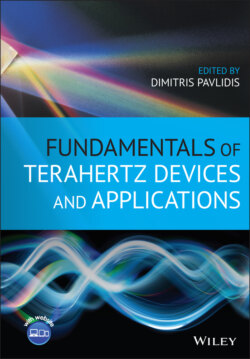Читать книгу Fundamentals of Terahertz Devices and Applications - Группа авторов - Страница 27
2.4.2 Primary Fields Radiated by a Leaky‐wave Antenna Feed on an Infinite Medium
ОглавлениеThis part will explain how to calculate the radiated fields into an infinite medium of a certain permittivity starting from a known aperture distribution. These fields can be then used as the incident fields in the previously explained lens analysis. We will use the example of a leaky‐wave feed over silicon but it can be applied to any source or lens dielectric material.
Figure 2.15 Sketch of the leaky‐wave feed with its main parameters. The red grid represents the field aperture grid.
The basic geometry of the feed is shown in Figure 2.15. A waveguide exciting the fundamental mode mounted under an infinite ground plane with an iris. Above the iris, there is a resonant air cavity and a silicon slab that extends infinitely in z and the xy plane.
Using Love's Equivalence Principle, the electric fields computed at the aperture plane (z = h) can be used to compute the equivalent magnetic and electric currents outside of the surface where is the normal vector to the aperture surface, in this case , and and are the electric fields computed at the aperture plane using the full‐wave simulator. The use of a full‐wave simulator will provide the accuracy to obtain the fields on an aperture grid, which will allow the computation of the currents using the free space Green's function and the equivalence principle. The infinite silicon medium can be simulated by setting absorbing boundaries in the full‐wave simulator. An electric field probe is set on the air‐silicon interface and will be the origin of our primary field origin of coordinates xyz (the plane is marked in red in Figure 2.15).
The lens can be in the radiative near field or far field of the feed. In the case of the leaky‐wave feed, due to its high directivity, the lens will be in most cases in the radiative near field. In the radiative region of the near‐field, the field can still be represented by a local spherical wave with an angular distribution that depends on the distance, and therefore the same PO explained previously can still be used. The near and far‐field effect is illustrated in Figure 2.16, where the fields are computed over a sphere of two certain radius ρ = 4.5λ and ρ = 20λ. The far field is calculated independently of the lens geometry, as the dependency in r is eliminated (i.e. the term e−jkr/r). This dependency is added when the equivalent currents are computed over the lens. From the phase shown in the radiation patterns, we can see that the phase center is not in the plane of the iris ground plane, as shown in Figure 2.15, it is below and it varies with frequency. Thus, in the contrary to the design equations on the previous sections, the lens extension height L and radius R will need adjustment to maximize the aperture efficiency of the overall antenna. This aperture efficiency will be computed over an aperture of diameter D (see Fig. 2.17a), which is smaller than the lens radius R because of the high directivity of the leaky‐wave feed.
Figure 2.16 Amplitude and phase of the electric centered at a central frequency 550 GHz in the (a) far‐field and (b) near‐field at ρ = 4.5 λ of the leaky‐wave feed radiating over an infinite silicon medium.
